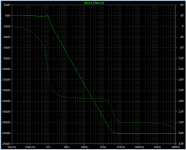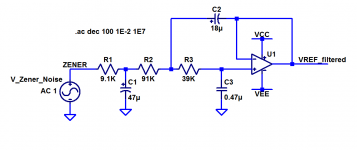I think there may be a pattern here. Pico likes to keep it simple but maybe Jam not so much.😀
I Just looked at the pics of the Pass hpa-1. It looks like it has a simple regulator but with some big caps behind it. So simple = good.🙂
I Just looked at the pics of the Pass hpa-1. It looks like it has a simple regulator but with some big caps behind it. So simple = good.🙂
Pico Rules.....
RobK,
Not quite.🙂 When I designed the Pass HPA-1 I had to do it within a certain price point in mind but the key was not to make any sonic compromises. If you look at the regulator it is designed to be as quiet as possible, within the scope of the costs and objectives. To improve on it with have cost quite a bit more.
My idea is to put everything you can(within reason) think of in the design and start removing anything that does not contribute towards it. Pico probably does the opposite but I am finding we probably both end up in the same place.
That being said in my own designs(for my personal use) can be a bit more complex.😀
Usually the complexity comes in form of the support circuitry to make a relative simple circuit sound better.
but still like Einstein said........
Jam
RobK,
Not quite.🙂 When I designed the Pass HPA-1 I had to do it within a certain price point in mind but the key was not to make any sonic compromises. If you look at the regulator it is designed to be as quiet as possible, within the scope of the costs and objectives. To improve on it with have cost quite a bit more.
My idea is to put everything you can(within reason) think of in the design and start removing anything that does not contribute towards it. Pico probably does the opposite but I am finding we probably both end up in the same place.

That being said in my own designs(for my personal use) can be a bit more complex.😀
Usually the complexity comes in form of the support circuitry to make a relative simple circuit sound better.
but still like Einstein said........
Jam
Attachments
Last edited:
I look forward to seeing how it all turns out and while I'm tuned in I might even try some vegemite, wait.... what is it made of?
Last edited:
I might even try some vegemite, wait.... what is it made of?
It’s best you don’t know till after you try it.
Hahaha
Jeff,
Operating the Zener too close to knee will be noisy.
I would be interesting to replace the zener with Vbe multiplier.
Jam
I would believe a Vbe multiplier could easily be 3 orders of magnitude less noisy than a 27V zener.
Maybe not the absolute best possible device with regards to temperature coefficient but I bet still a lot better than a 27V Zener.
Otherwise a string of leds or even 4.7V or 5.1V Zeners would be quite a bit better, or any other favourite reference device.
I doubt any of these details would be accurately modelled in spice, I’ve come across so many inaccurate spice models it’s ridiculous.
Some diode models don’t even have af or kf parameters and if they do they’re probably innacurate.
...Otherwise a string of leds or even 4.7V or 5.1V Zeners would be quite a bit better, or any other favourite reference device....
So it's the dynamic resistance I'm trying to minimise?
I did some reading and there's true Zener breakdown (Vz < 6.2V) and avalanche mode Zener breakdown (Vz >= 6.2V). This appears to be more of a factor than dynamic resistance....
Plain ordinary 1Nxxxx "zener diodes" are often accused of being noisy.** That's why Walt Jung has been studiously avoiding them for 30 years, when he develops the "VREF" portion of a voltage regulator circuit design. At first, Walt employed the LM329 IC which contains a "buried zener" and is spec'd and measured to have low noise (see image below).
Now Walt is using an even lower noise VREF circuit which he has named "GLED431". Unlike the 6.9V LM329, Walt's new circuit has a VREF output voltage that's comfortably below 5V. This is desirable in these modern times, when you need to build a supremely good voltage regulator that provides 5.00V to low-voltage modern ICs.
Here is Walt's write up of the GLED431
https://www.diyaudio.com/forums/att...-reference-cell-_walts-blog-2014_092418_r-pdf
** diyAudio member gerhard disagrees, he presents some measured data (here)
Now Walt is using an even lower noise VREF circuit which he has named "GLED431". Unlike the 6.9V LM329, Walt's new circuit has a VREF output voltage that's comfortably below 5V. This is desirable in these modern times, when you need to build a supremely good voltage regulator that provides 5.00V to low-voltage modern ICs.
Here is Walt's write up of the GLED431
https://www.diyaudio.com/forums/att...-reference-cell-_walts-blog-2014_092418_r-pdf
** diyAudio member gerhard disagrees, he presents some measured data (here)
Attachments
Last edited:
Thanks for those links, Mark.
In other news, I spent too much time looking at the top side of the regulator. The negative side had no margins. 🙁
The fix was to slow down the LTP (MPSA06/56). Since the N and P parts have quite different speeds, the base stoppers came in handy. 😉
(Oh, and the overall specs improved slightly. 70dB & 10mOhms down to 1Hz now.)
In other news, I spent too much time looking at the top side of the regulator. The negative side had no margins. 🙁
The fix was to slow down the LTP (MPSA06/56). Since the N and P parts have quite different speeds, the base stoppers came in handy. 😉
(Oh, and the overall specs improved slightly. 70dB & 10mOhms down to 1Hz now.)
Jeff,
Good work on the negative regulator. Base stopper resistors rule.
Please read from our own forum, invaluable information by Christer. Pay specific attention to current vs. noise figures for the various devices.
Some noise measurements for LEDs and zener diodes
In this application the zener is probably fine and we might end up splitting hairs for no real world gain.
Jam
Good work on the negative regulator. Base stopper resistors rule.
Please read from our own forum, invaluable information by Christer. Pay specific attention to current vs. noise figures for the various devices.
Some noise measurements for LEDs and zener diodes
In this application the zener is probably fine and we might end up splitting hairs for no real world gain.
Jam
Last edited:
Well now that was a fascinating thread. (There's also an aside near the end into the effects of using a current source for your Zener/LED/what-have-you: Noise in voltage references.)
My take-aways (in priority order):
1) Use a current source
2) This is not the right place for a TL431
3a) If using a Zener stay away from the 6.3V cross-over region
3b) If using a LED stay away from blue
4) Zener bypass cap of questionable value (though doesn't harm and still good for slow-turn-on)
Your mileage may vary.
My take-aways (in priority order):
1) Use a current source
2) This is not the right place for a TL431
3a) If using a Zener stay away from the 6.3V cross-over region
3b) If using a LED stay away from blue
4) Zener bypass cap of questionable value (though doesn't harm and still good for slow-turn-on)
Your mileage may vary.
Oh, and this lovely gem (in relation to the sweet-spot for LED current):

.... The differences in the 2-8mA range are so small that is mostly an academic exercise to even bother about this, but since I am an academic I was stupid enough to waste some time on it.

gerhard here has some measurements of some zeners and leds. That HLMP-6000 led looks good. He says zeners get worse as the voltage rating goes up.
Mr. Jung's ultra-low noise VREF - the GLED431
and here.
Mr. Jung's ultra-low noise VREF - the GLED431
Mr. Jung's ultra-low noise VREF - the GLED431
and here.
Mr. Jung's ultra-low noise VREF - the GLED431
.... He says zeners get worse as the voltage rating goes up....
But he only goes up to the cross-over region, no? Christer's work would suggest it starts going back down again not long after that.
It’s best you don’t know till after you try it.
Hahaha
Oh, so should be long after I try it, like on an empty stomach.
One way to get rid of reference noise is to filter it. This 3rd order Chebyshev filter with 1dB of passband ripple, seems to reduce noise by many factors of ten. (-220dB = 10 raised to the power minus eleven). I deliberately chose Chebyshev, to allow others to exhibit the superiority or inferiority of a Butterworth filter or a Cauer filter, in an application to eliminate reference noise.
_
_
Attachments
- Home
- Amplifiers
- Pass Labs
- JamJar: an HPA-1-inspired power amp




